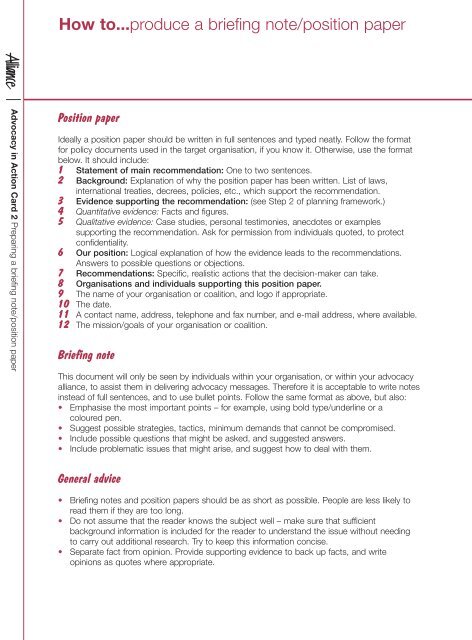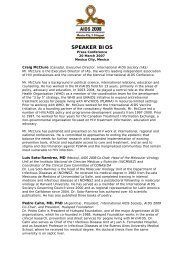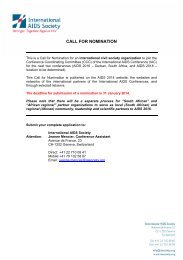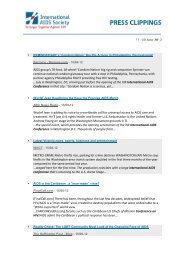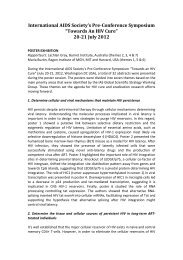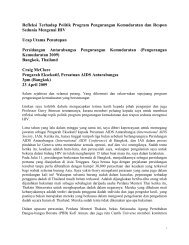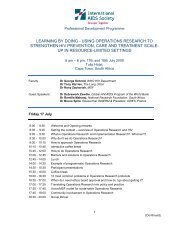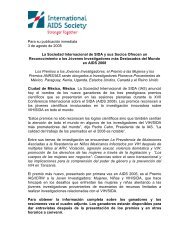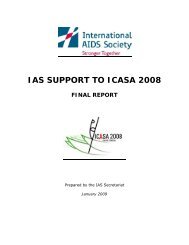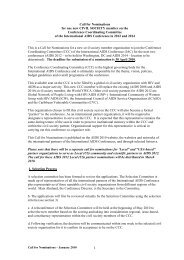Advocacy in Action - International AIDS Society
Advocacy in Action - International AIDS Society
Advocacy in Action - International AIDS Society
You also want an ePaper? Increase the reach of your titles
YUMPU automatically turns print PDFs into web optimized ePapers that Google loves.
How to...produce a brief<strong>in</strong>g note/position paper<br />
<strong>Advocacy</strong> <strong>in</strong> <strong>Action</strong> Card 2 Prepar<strong>in</strong>g a brief<strong>in</strong>g note/position paper<br />
Position paper<br />
Ideally a position paper should be written <strong>in</strong> full sentences and typed neatly. Follow the format<br />
for policy documents used <strong>in</strong> the target organisation, if you know it. Otherwise, use the format<br />
below. It should <strong>in</strong>clude:<br />
1 Statement of ma<strong>in</strong> recommendation: One to two sentences.<br />
2 Background: Explanation of why the position paper has been written. List of laws,<br />
<strong>in</strong>ternational treaties, decrees, policies, etc., which support the recommendation.<br />
3 Evidence support<strong>in</strong>g the recommendation: (see Step 2 of plann<strong>in</strong>g framework.)<br />
4 Quantitative evidence: Facts and figures.<br />
5 Qualitative evidence: Case studies, personal testimonies, anecdotes or examples<br />
support<strong>in</strong>g the recommendation. Ask for permission from <strong>in</strong>dividuals quoted, to protect<br />
confidentiality.<br />
6 Our position: Logical explanation of how the evidence leads to the recommendations.<br />
Answers to possible questions or objections.<br />
7 Recommendations: Specific, realistic actions that the decision-maker can take.<br />
8 Organisations and <strong>in</strong>dividuals support<strong>in</strong>g this position paper.<br />
9 The name of your organisation or coalition, and logo if appropriate.<br />
10 The date.<br />
11 A contact name, address, telephone and fax number, and e-mail address, where available.<br />
12 The mission/goals of your organisation or coalition.<br />
Brief<strong>in</strong>g note<br />
This document will only be seen by <strong>in</strong>dividuals with<strong>in</strong> your organisation, or with<strong>in</strong> your advocacy<br />
alliance, to assist them <strong>in</strong> deliver<strong>in</strong>g advocacy messages. Therefore it is acceptable to write notes<br />
<strong>in</strong>stead of full sentences, and to use bullet po<strong>in</strong>ts. Follow the same format as above, but also:<br />
• Emphasise the most important po<strong>in</strong>ts – for example, us<strong>in</strong>g bold type/underl<strong>in</strong>e or a<br />
coloured pen.<br />
• Suggest possible strategies, tactics, m<strong>in</strong>imum demands that cannot be compromised.<br />
• Include possible questions that might be asked, and suggested answers.<br />
• Include problematic issues that might arise, and suggest how to deal with them.<br />
General advice<br />
• Brief<strong>in</strong>g notes and position papers should be as short as possible. People are less likely to<br />
read them if they are too long.<br />
• Do not assume that the reader knows the subject well – make sure that sufficient<br />
background <strong>in</strong>formation is <strong>in</strong>cluded for the reader to understand the issue without need<strong>in</strong>g<br />
to carry out additional research. Try to keep this <strong>in</strong>formation concise.<br />
• Separate fact from op<strong>in</strong>ion. Provide support<strong>in</strong>g evidence to back up facts, and write<br />
op<strong>in</strong>ions as quotes where appropriate.


